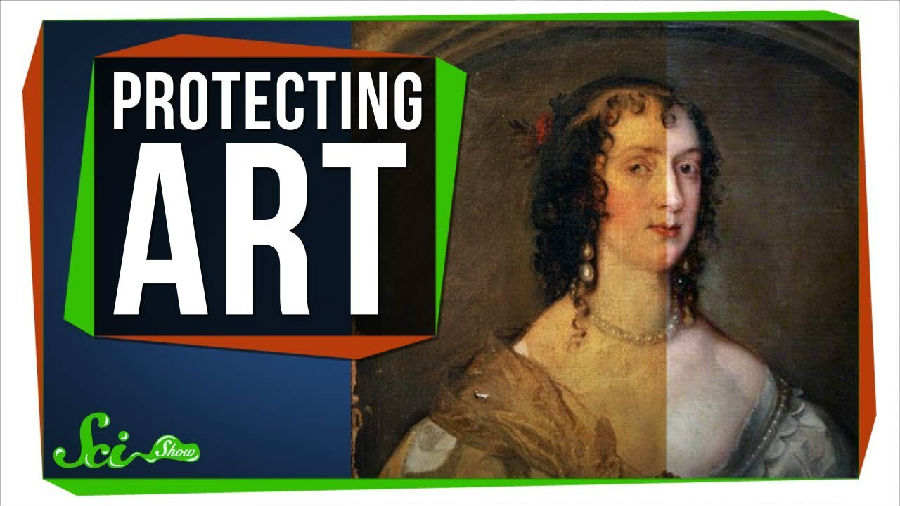Artists create all sorts of paintings, sculptures, and architecture that help make our world beautiful and capture moments in history.
艺术家们创造出了各种名画、雕塑和建筑,捕捉到了历史的时刻,让我们的世界更加美丽。
But without scientists, we would've lost most of this art by now. Art gets dirty and damaged over time.
但是没有科学家的话,现在的我们或许会失去大量的艺术品。艺术品也会随着时间的流逝而损毁。
And if you try to clean it without paying attention to chemistry, you could do more harm than good.
而且如果你在试图清理这些艺术品的时候忽视了其化学特性,那么这些艺术品会遭到更多的破坏。
Thankfully, scientists have been learning how to restore artwork in some pretty cool ways that are effective and safe.
幸好科学家们一直在研究如何安全有效的保存这些艺术品。
And a little weird, to be honest. One way of cleaning 3-D artwork — like, sculptures or architecture — is by blasting it with a laser.
说实话有些奇怪。清理3D艺术品(比如雕塑或建筑)的方法之一是利用激光进行冲击。
Which sounds counterintuitive... but awesome.
这听起来违反常理,但却非常棒。
This method is called laser ablation, and it was first developed in the 1970s to get something called black crust off marble.
这种方法被称为激光消融,首次研制于1970年代用于除掉大理石雕像上的黑色外壳。
This crust is a combination of pollution from the environment and the mineral gypsum — which can form if marble is exposed to acid rain.
这种外壳是环境和矿物石膏污染的结合—如果大理石雕像暴露在酸雨中就会形成这种外壳。
And it can be hard to get off.
而且很难去除。
Using chemicals or scraping it isn't always precise and can damage the art underneath.
利用化学物质或刮掉这层外壳达不到精确要求,还会对里边的艺术品造成损坏。
Laser ablation gets around those problems by using short pulses from a handheld laser to dislodge grime.
激光消融利用手持激光射出的短脉冲清除这些污垢从而解决了这个问题。
To make sure conservators don't accidentally melt any statues, the length of the pulse is carefully controlled by a computer,
为了确保维护人员不会意外消融任何雕塑,脉冲的长度由电脑仔细控制,
and it usually only lasts a few millionths or even billionths of a second.
脉冲通常只能持续百万分之一,甚至十亿分之一秒。
The lasers also use infrared light, since that has a longer wavelengths and carries less potentially-damaging energy than visible light.
激光也会使用红外线,因为红外线波长更长且比可见光所携带的潜在损坏能量更小。
Once the laser is turned on, the light heats up and expands the black crust.
一旦激光打开,光线将黑色外壳加热并使其膨胀。
That expansion creates waves of pressure that ultimately detach the grime — all without affecting the marble underneath.
膨胀创造出几波压力,最终将所有污垢分离且丝毫没有影响到里面的大理石雕像。
It's actually a little like how tattoo removal works except those lasers are breaking up the ink in your cells into smaller pieces, not blasting it off your body.
事实上,这有点像是清洗纹身,除了那些激光是讲你细胞中的墨水分解成小块,而非将其冲离你的身体。
Lasers might seem like the gold standard for cool science.
激光看上去像是趣味科学的黄金标准。
But to repair some paintings, scientists got even more creative: They trained dirt-eating bacteria.
但是为了修补一些名画,科学家们甚至有更加创造力的想法:他们训练了一些污垢清理细菌。
A few years ago, art conservators in Italy were working to repair a series of 400-year-old frescoes — a kind of painting done on wet plaster.
几年前,意大利的艺术品维护人员合作修复一系列四百年前的壁画—一种在潮湿的石膏上所作的画。
After decades of pigeon poop and harmful restoration attempts, the frescoes were in pretty bad shape.
经过几十年鸽子便便的洗礼以及错误的修复尝试后,这些壁画遭严重破坏。
They were covered in waste, salt, and glues from those older, botched restorations.
陈旧的错误修复方法让它们覆盖上各种垃圾、盐和胶水中。
And to make things even worse, the chemicals that conservators were using to try and clean them were actually damaging the paint.
更糟糕的是,维护人员用来清理壁画的化学物质实际上对壁画造成了伤害。
That's where bacteria came in.
细菌就这样出现了。
By working with microbiologists, the conservators identified a strain of bacteria that could actually eat the salts and glues right off the paintings.
通过和微生物学家的合作,维护人员确认一种细菌能够吃掉画上的这些盐分和胶水。

In only a few hours, it removed 80% of the damage without touching the pigments underneath.
仅几个小时内,在没有触碰里边颜料的情况下,80%的损毁被清除。
It's called Pseudomonas stutzeri, and it's pretty common in dirt and water.
这种细菌被称为施氏假单胞菌,在泥垢和水中相当常见。
These bacteria can get energy from all kinds of compounds, and they'll actually produce different proteins depending on the food source they're given.
这些细菌能从所有化合物中获取能量,它们真的可以依据所吃的食物源产生不同蛋白质。
So by growing them in specific mixtures of old glues and salts, biologists can actually "train" the bacteria to make proteins that eat away the grime on frescoes.
通过在特制的胶水和盐混合物中培育它们,生物学家真的可以训练这些细菌让它们制造蛋白质,吃掉壁画上的污垢。
As long as they don't include pigments in the training mix, the bacteria won't touch the original artwork, either.
只要训练混合物中不包含污垢,这些细菌就不会触碰原画。
After a few hours with these organisms, the paintings looked practically as good as new.
和这些生物体相处几个小时后,壁画几乎和新的一样好。
Or at least, way better than they did.
至少,比之前好。
Bacteria has since been used to clean more paintings, some up to 700 years old.
自那时,细菌就被用于清理更多的名画,有的甚至是七百年前的画作。
And besides helping us, they're getting a free meal out of it — so it's a win-win.
除了能够帮助我们外,它们还吃到了免费食物,所以,这简直是双赢。
Now, possibly the most satisfying method of art restoration is cleaning off yellowed varnish with some careful chemistry.
现在,艺术修复最令人满意的方法是利用一些特别化学物清理发黄的清漆。
For real, you can watch all kinds of videos of this online.
确实,你可以在线观看各种相关视频。
Varnish is applied to oil or acrylic paintings for a few reasons, including to protect the art from dirt.
将亮光漆应用于油画或丙烯画的原因有几点,其中包括防尘。
Formulas can vary, but it's generally made of a drying oil, a resin, and some sort of thinner.
虽然配方各异,但通常是由一种干性油、树脂和一些稀释剂制成。
The resin is a sticky substance — like pine resin — and it forms a hard coating on the painting after everything dries.
树脂是一种粘性物质—比如松木树脂—并且在画作干后,它能在画上形成一种坚硬的涂层。
The problem is, resins often change color over time.
问题是,时间久了,树脂常会变色。
After years of exposure to light or oxygen, compounds in them break down and turn yellow or even brown. And it's not pretty.
多年暴露在阳光或氧气之下,其中的化合物质被分解并变成黄色甚至棕色就不漂亮了。
Taking off the old varnish is a challenge, because the chemicals used to do it can just as easily erode the paint underneath.
除去这一层亮光漆是一个挑战,因为用于去除亮光漆的化学物质也会轻易地腐蚀内部的画作。
So art conservators have to become chemists.
所以艺术品维护人员不得不成为化学家。
First, they'll slowly wipe away the old varnish using a chemical like acetone, a carbon-based molecule that's great at dissolving resin.
首先,他们要用丙酮等化学物质慢慢擦掉这层亮光漆,丙酮是一种碳基材料分子,擅于消融树脂
Then, they also have to remove the acetone residue, so it doesn't keep dissolving the original paint.
然后,他们还必须清理这些丙酮残留物,这样才不会将原画消融。
To do that, they'll use a neutralizer.
为了清理残留物,他们要使用一种中和剂。
These are often mixes of chemicals — like oils — that stop a varnish remover from reacting, or from being so acidic or basic.
这些通常是各种化学物的混合—比如油类—能够阻止一种亮光漆起反应或变成酸性。
The exact chemical they'll use will depend on the remover itself.
他们使用何种化学混合物则取决于移除本身。
For example, with acetone, they can use a mix of petroleum and wintergreen oil.
例如,用丙酮的话,他们可以使用石油和冬青油的混合。
Then, once everything is clean, the painting is ready to be re-varnished or put back on display.
然后,一旦清理干净,画作就将被再次涂上亮光漆或是放回陈列柜中。
Without science, conservators could accidentally turn a work of art into, well, kind of a mess.
没有科学的话,维护人员确可能会不小心将艺术品变得一团糟。
But thanks to techniques like these, they can keep preserving beautiful pieces of art — and history — so we can enjoy them for decades to come.
但多亏了有这些技术,他们才能够保存这些美丽的艺术品和历史,我们才能在未来几十年里欣赏它们。
Thanks for watching this episode of SciShow! Besides restoring art, scientists are also pretty talented at busting art forgeries.
感谢收看本期《科学秀》!除了修复艺术品,科学家们还非常擅于爆破赝品。
If you'd like to learn how, you can watch our episode all about it.
如果感兴趣,请观看相关视频。











